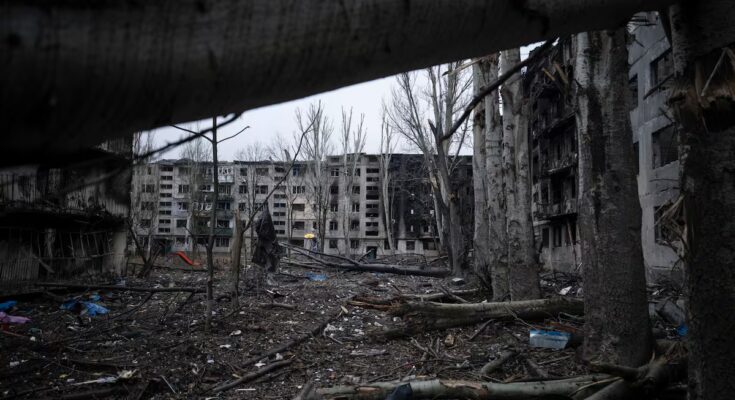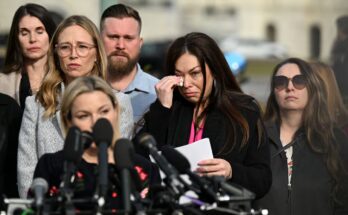A Russian soldier with a blurred face poses in front of the bodies of three Ukrainian soldiers who lie with their hands near their heads, face down, in a pool of blood. The image, released by the Russian unit Rúsich on its Telegram channel, is accompanied by the announcement of a competition: “The first three people to send a photo with prisoners clearly erased from existence will receive a reward in cryptocurrencies.” It is a war crime, another one, in the total war that the Kremlin calls a “special military operation”. This time, however, it sparked a competition in which Ukrainian forces also joined.
The photograph was broadcast for the first time last week by other Russian ultranationalist channels. Later, a fighter from the Russian Volunteer Corps, a unit that supports Ukraine and fights against the Kremlin, saw it and posted it on his Instagram profile demanding revenge. Rúsich saw his publications and took this spiral until it turned into a bloody prize competition.
“Take an example from the enemy: this is a victorious army, not a gang,” said the pro-Ukrainian soldier, nicknamed Slavián, while calling for imitation of his enemies.
The soldier shared in his following stories some images that other Ukrainian soldiers sent him posing with the bodies of dead Russian fighters. In another video, a soldier shot an already dead Russian in the head in the middle of the forest next to a writing: “Long live death.” According to what the Russian Volunteer Corps reported to the independent news channel Sota, their official position “is not to touch the prisoners”, and Slavián’s challenge only includes “taking photos with the dead soldiers”. An extreme that could not be verified.
Slavián’s words were paraphrased by Rúsich days later. “Take an example. This is how you photograph a victorious army, not a defeated one,” the unit responded this weekend, announcing its competition.
This is not the first time the unit has proposed executing prisoners of war. At the start of the invasion in 2022, after learning of the first exchanges of surrendered soldiers between Moscow and Kiev, the unit published a guide entitled “Instructions for the elimination of prisoners of war of the Armed Forces of Ukraine.”
The document recommended not informing soldiers of other Russian companies about the executions. “If it has been reported, report that the enemy is wounded and may die,” they advised.
However the executions are not exceptional. In 2024, Ukraine reported a wave of murders of its prisoners. And Russian President Vladimir Putin posed a year ago with the flag of the 155th Marine Brigade in his traditional annual address to the media and citizens. That unit, in fact, had been accused of impaling the severed heads of Ukrainian soldiers.
According to what some Russian veterans told this newspaper, snipers and drone pilots are usually the rivals most in danger when they surrender. Their killings, shown in the videos, range from being shot at point blank range to having their throats slit. “The front is terrible. The shock it makes it impossible for some to behave humanely. A person who experiences this cannot be normal after the war, neither in one country nor in another,” a Russian commander said months ago.
The Geneva Convention on the Treatment of Prisoners of War, to which Russia and Ukraine are signatories, expressly rejects the execution of surrendered soldiers.
“Attacks on life and physical integrity, in particular murder in all its forms, mutilations, cruel treatment, torture and punishment, are prohibited at all times and places,” reads the document, a pillar of international law, in Article 3.
In any case, it is the Kremlin and Kiev, and not Rusich or any other specific unit, who are ultimately responsible for these war crimes. “Prisoners of war are in the power of the enemy power and not of the individuals or troops who captured them. Regardless of individual responsibilities, the detaining power is responsible for the treatment they receive,” the Geneva Convention emphasizes.
Furthermore, the document provides that if the conflicting power cannot guarantee the protection of prisoners, it must entrust their safety to a neutral state or organizations such as the Red Cross.
“Glory to Rus! Glory to Morana!” is the cry with which Rusich concluded his prisoner execution contest. The word “Rus” refers to several ancient Eastern European peoples of uncertain origins who gave rise to the founding of Kievan Rus, the first of several medieval Slavic states. Morana, for her part, was the pagan goddess of death.
Rúsich, now integrated into the Russian army, was a unit of the Wagner mercenary company. The group is known for not hiding its far-right ideology. Its leader, Alexei Milchakov, declared himself a Nazi in a media interview in 2014. Sputnik and Pogromand its symbol is the Kolovrat, a rune similar to an eight-armed swastika popularized by one of the fathers of Slavic neopaganism in Russia, Alexei Dobrovolsky. The military patch is complemented by the white, yellow and black colors of the Imperial Russian flag.
The Russian Volunteer Corps (RDK) was founded by exiles with the goal of overthrowing the Kremlin. Its leader is Denis Kapustin, also known as Denis Nikitin, a martial arts fighter who has been linked to far-right groups in Europe and who has been banned by Germany from entering the Schengen area.


